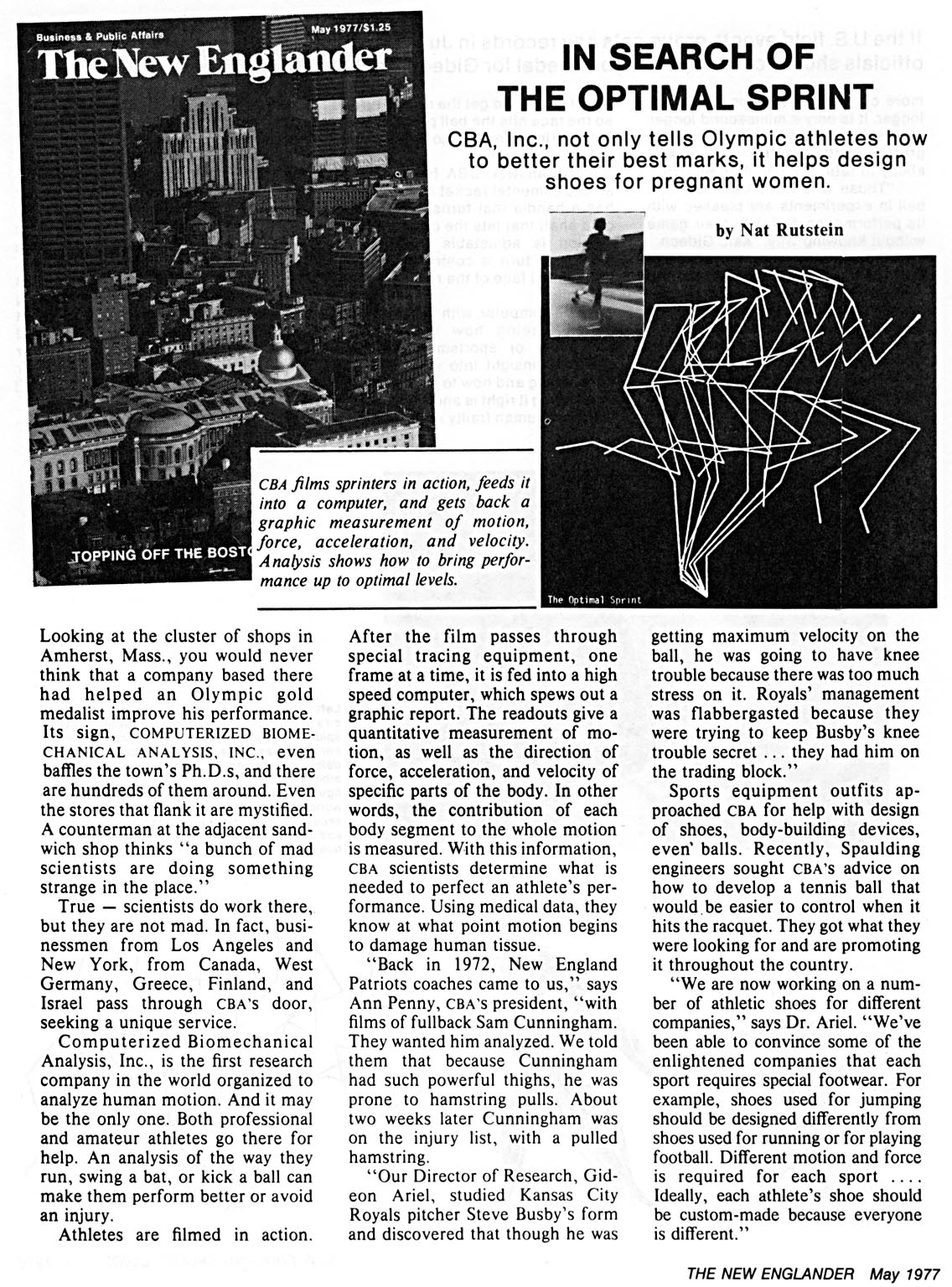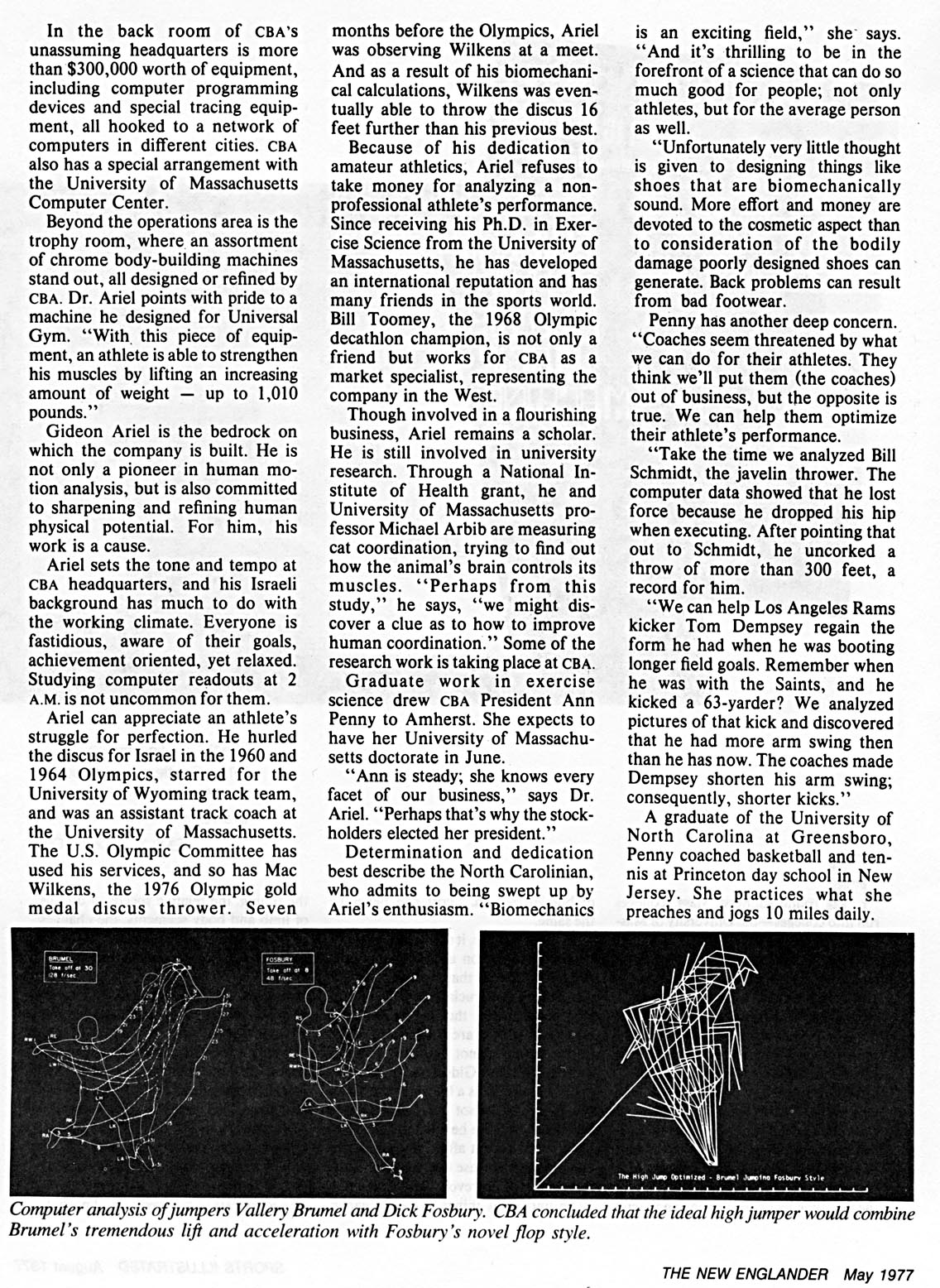In Search of the Optimal Sprint
CBA, Inc., not only tells Olympic athletes how to better their best marks, it helps design shoes for pregnant women.
By Nat Rutstein in The New Englander on Sunday, May 1, 1977
The article discusses the work of Computerized Biomechanical Analysis, Inc. (CBA), a company that uses computer analysis to improve athletic performance and design sports equipment. CBA films athletes in action and feeds the footage into a computer, which provides a graphic measurement of motion, force, acceleration, and velocity. This data is then used to optimize performance and prevent injury. The company has worked with Olympic athletes, professional sports teams, and sports equipment manufacturers. CBA's research has also been applied to the design of athletic shoes, with the company arguing that each sport requires specific footwear. The company's founder, Gideon Ariel, is a former Olympic athlete and remains committed to improving human physical potential.
Tip: use the left and right arrow keys
IN SEARCH OF THE OPTIMAL SPRINT
CBA, Inc., not only tells Olympic athletes howto better their best marks, it helps designshoes for pregnant women.
CBA films sprinters in action, feeds it into a computer, and gets back a graphic measurement of motion, force, acceleration, and velocity. Analysis shows how to bring performance up to optimal levels.
Looking at the cluster of shops in Amherst, Mass., you would never think that a company based there had helped an Olympic gold medalist improve his performance.
Its sign, COMPUTERIZED BIOMECHANICAL ANALYSIS, INC., even baffles the town's Ph.D.s, and there are hundreds of them around. Even the stores that flank it are mystified. A counterman at the adjacent sandwich shop thinks "a bunch of mad scientists are doing something strange in the place."
True - scientists do work there, but they are not mad. In fact, businessmen from Los Angeles and New York, from Canada, West Germany, Greece, Finland, and Israel pass through CBA's door, seeking a unique service.
Computerized Biomechanical Analysis, Inc., is the first research company in the world organized to analyze human motion. And it may be the only one. Both professional and amateur athletes go there for help. An analysis of the way they run, swing a bat, or kick a ball can make them perform better or avoid an injury.
Athletes are filmed in action.
After the film passes through special tracing equipment, one frame at a time, it is fed into a high speed computer, which spews out a graphic report. The readouts give a quantitative measurement of motion, as well as the direction of force, acceleration, and velocity of specific parts of the body. In other words, the contribution of each body segment to the whole motion is measured. With this information, CBA scientists determine what is needed to perfect an athlete's performance. Using medical data, they know at what point motion begins to damage human tissue.
"Back in 1972, New England Patriots coaches came to us," says Ann Penny, CBA'S president, "with films of fullback Sam Cunningham. They wanted him analyzed. We told them that because Cunningham had such powerful thighs, he was prone to hamstring pulls. About two weeks later Cunningham was on the injury list, with a pulled hamstring.
"Our Director of Research, Gideon Ariel, studied Kansas City Royals pitcher Steve Busby's form and discovered that though he was getting maximum velocity on the ball, he was going to have knee trouble because there was too much stress on it. Royals' management was flabbergasted because they were trying to keep Busby's knee trouble secret ... they had him on the trading block."
Sports equipment outfits approached CBA for help with design of shoes, body-building devices, even' balls. Recently, Spaulding engineers sought CBA's advice on how to develop a tennis ball that would be easier to control when it hits the racquet. They got what they were looking for and are promoting it throughout the country.
"We are now working on a number of athletic shoes for different companies," says Dr. Ariel. "We've been able to convince some of the enlightened companies that each sport requires special footwear. For example, shoes used for jumping should be designed differently from shoes used for running or for playing football. Different motion and force is required for each sport .... Ideally, each athlete's shoe should be custom-made because everyone is different."
THE NEW ENGLANDER May 1977
In the back room of CBA'S unassuming headquarters is more than $300,000 worth of equipment, including computer programming devices and special tracing equipment, all hooked to a network of computers in different cities. CBA also has a special arrangement with the University of Massachusetts Computer Center.
Beyond the operations area is the trophy room, where an assortment of chrome body-building machines stand out, all designed or refined by CBA. Dr. Ariel points with pride to a machine he designed for Universal Gym. "Withh this piece of equipment, an athlete is able to strengthen his muscles by lifting an increasing amount of weight - up to 1,010 pounds."
Gideon Ariel is the bedrock on which the company is built. He is not only a pioneer in human motion analysis, but is also committed to sharpening and refining human physical potential. For him, his work is a cause.
Ariel sets the tone and tempo at CBA headquarters, and his Israeli background has much to do with the working climate. Everyone is fastidious, aware of their goals, achievement oriented, yet relaxed. Studying computer readouts at 2 A.M. is not uncommon for them.
Ariel can appreciate an athlete's struggle for perfection. He hurled the discus for Israel in the 1960 and 1964 Olympics, starred for the University of Wyoming track team, and was an assistant track coach at the University of Massachusetts. The U.S. Olympic Committee has used his services, and so has Mac Wilkens, the 1976 Olympic gold medal discus thrower. Seven months before the Olympics, Ariel was observing Wilkens at a meet. And as a result of his biomechanical calculations, Wilkens was eventually able to throw the discus 16 feet further than his previous best.
Because of his dedication to amateur athletics, Ariel refuses to take money for analyzing a nonprofessional athlete's performance. Since receiving his Ph.D. in Exercise Science from the University of Massachusetts, he has developed an international reputation and has many friends in the sports world. Bill Toomey, the 1968 Olympic decathlon champion, is not only a friend but works for CBA as a market specialist, representing the company in the West.
Though involved in a flourishing business, Ariel remains a scholar. He is still involved in university research. Through a National Institute of Health grant, he and University of Massachusetts professor Michael Arbib are measuring cat coordination, trying to find out how the animal's brain controls its muscles. "Perhaps from this study," he says, "we might discover a clue as to how to improve human coordination." Some of the research work is taking place at CBA.
Graduate work in exercise science drew CBA President Ann Penny to Amherst. She expects to have her University of Massachusetts doctorate in June.
"Ann is steady; she knows every facet of our business," says Dr. Ariel. "Perhaps that's why the stockholders elected her president."
Determination and dedication best describe the North Carolinian, who admits to being swept up by Ariel's enthusiasm. "Biomechanics is an exciting field," she says. "And it's thrilling to be in the forefront of a science that can do so much good for people; not only athletes, but for the average person as well.
"Unfortunately very little thought is given to designing things like shoes that are biomechanically sound. More effort and money are devoted to the cosmetic aspect than to consideration of the bodily damage poorly designed shoes can generate. Back problems can result from bad footwear.
Penny has another deep concern. "Coaches seem threatened by what we can do for their athletes. They think we'll put them (the coaches) out of business, but the opposite is true. We can help them optimize their athlete's performance.
"Take the time we analyzed Bill Schmidt, the javelin thrower. The computer data showed that he lost force because he dropped his hip when executing. After pointing that out to Schmidt, he uncorked a throw of more than 300 feet, a record for him.
"We can help Los Angeles Rams kicker Tom Dempsey regain the form he had when he was booting longer field goals. Remember when he was with the Saints, and he kicked a 63-yarder? We analyzed pictures of that kick and discovered that he had more arm swing then than he has now. The coaches made Dempsey shorten his arm swing; consequently, shorter kicks."
A graduate of the University of North Carolina at Greensboro, Penny coached basketball and tennis at Princeton day school in New Jersey. She practices what she preaches and jogs 10 miles daily.
Computer analysis of jumpers Vallery Brumel and Dick Fosbun�. CBA concluded that the ideal high jumper would combine Brumel's tremendous lift and acceleration x�ith Fosbun.'s novel flop style.
THE NEW ENGLANDER May 1977


